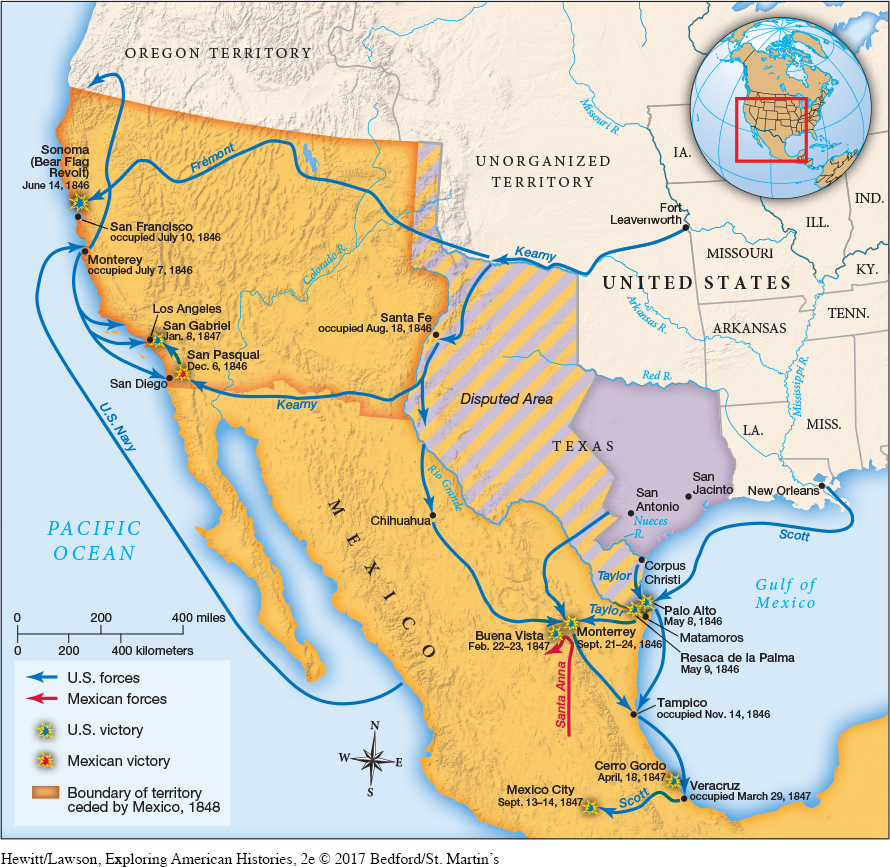Pursuing War with Mexico
At the same time, with Texas now a state, Mexico faced growing tensions with the United States. Conflicts centered on Texas’s western border. Mexico insisted on the Nueces River as the boundary line, while Americans claimed all the land to the Rio Grande. In January 1846, Polk secretly sent emissary John Slidell to negotiate a border treaty with Mexico. But Polk also sent U.S. troops under General Zachary Taylor across the Nueces River. Mexican officials refused to see Slidell and instead sent their own troops across the Rio Grande. Meanwhile U.S. naval commanders prepared to seize San Francisco Bay from the Mexicans if war was declared. The Mexican government responded by sending more troops into the disputed Texas territory.
When fighting erupted near the Rio Grande in May 1846 (Map 10.3), Polk claimed that “American blood had been shed on American soil” and declared a state of war. Many Whigs in Congress opposed the declaration, arguing that the president had provoked the conflict. However, antiwar Whigs failed to convince the Democratic majority, and Congress voted to finance the war. Although northern opponents of slavery protested the war, most Americans—North and South—considered westward expansion a boon.

Once the war began, battles erupted in a variety of locations. In May 1846, U.S. troops defeated Mexican forces in Palo Alto and Resaca de la Palma. A month later, the U.S. army captured Sonoma, California, with the aid of local settlers. John Frémont then led U.S. forces to Monterey, where the navy launched a successful attack and declared the California territory part of the United States. That fall, U.S. troops gained important victories at Monterrey, Mexico, just west of the Rio Grande, and Tampico, along the Gulf coast.
Explore
For one artist’s view of Americans’ interest in the Mexican War, see Document 10.4.
Despite major U.S. victories, Santa Anna, who reclaimed the presidency of Mexico during the war, refused to give up. In February 1847, his troops attacked U.S. forces at Buena Vista and nearly secured a victory. Polk then agreed to send General Winfield Scott to Veracruz with 14,000 soldiers. Capturing the port in March, Scott’s army marched on to Mexico City. After a crushing defeat of Santa Anna at Cerro Gordo, the president-general was removed from power and the new Mexican government sought peace.
With victory ensured, U.S. officials faced a difficult decision: How much Mexican territory should they claim? The U.S. army in central Mexico faced continued guerrilla attacks. Meanwhile Whigs and some northern Democrats denounced the war as a southern conspiracy to expand slavery. In this context, Polk agreed to limit U.S. claims to the northern regions of Mexico. The president signed the Treaty of Guadalupe Hidalgo in February 1848, committing the United States to pay Mexico $15 million in return for control over Texas north and east of the Rio Grande plus California and the New Mexico territory.
Exploring American HistoriesPrinted Page 336
Exploring American Histories Value EditionPrinted Page 250
Chapter Timeline